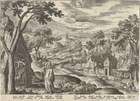Gallery 4:
The Zodiac Series

Title page of the Emblemata Evangelica, a series of twelve engravings.
In 1585, one of the members of the Sadeler family of printers and engravers published a set of twelve engravings by Adriaen Collaert after designs by Hans Bol. These engravings were introduced by a title page which described them as "gospel emblems set according to the twelve celestial signs and the twelve months of the year […] Thus Christ leads the idolaters of stars and planets to worship the only Creator of all things." The title page concludes by recalling the Book of Genesis, which recounts that "at the outset, stars and planets were created by God to tell time."
The twelve emblemata engraved by Collaert were painted by Diego Quispe Tito in Cuzco in 1681 (Mesa and Gisbert 1982, I, 157). Unfortunately, the current whereabouts of three of these paintings—Aries, Gemini, Virgo—are unknown. The engraved sources of the missing paintings are shown below in the hopes that they might lead us to their painted descendants.

Adriaen Collaert (after Hans Bol): The Parable of the Sower (Aries).

Adriaen Collaert (after Hans Bol): Christ and the woman of Samaria (Gemini)

Adriaen Collaert (after Hans Bol): Heads of wheat plucked on the Sabbath (Virgo)
The paintings authored by Quispe Tito constitute one of the few known examples of a Spanish Colonial work based on the signs of the Zodiac. This rarity could be due to a variety of reasons. Philosophically, belief in the Zodiac undermines the Christian doctrine of free will; theologically, it challenges the omnipotence of God, and catechetically, it works at cross-purposes by reinforcing pagan cults that the Catholic Church was seeking to extirpate in the Americas (Hautekeete 2015, 31). Indeed, in his Tesoros verdaderos de las Indias (1682), the religious chronicler Juan Meléndez warned us that en Indias […] suele suceder que se vuelve a los ídolos, y a sus ritos y ceremonias antiguas […] y asi se tiene mandado, que no sólo en las iglesias, sino en ninguna parte, ni pública ni secreta de los pueblos de los Indios, se pinte el sol, la luna, ni las estrellas por quitarles la ocasión de volver (como está dicho) a sus antiguos delirios y disparates (Tord 1989, 181f). In light of all this —and in spite of the statements to the contrary made in the title page of the printed series— it seems unlikely that these paintings were commissioned in support of the catechesis of the indigenous population (Mesa and Gisbert 1982, I, 157).
The question remains, however, of the role played by the signs of the Zodiac in these compositions. In some cases, they were clear literary allusions. Pisces and the calling of Peter and Andrew to become fisher of men, for example. In other cases, they corresponded to times of the year which could themselves serve as literary allusions. Aries, for example, corresponds to the time of sowing (at least in the Northern Hemisphere). Thus a landscape under Aries becomes a suitable setting for the Parable of the Sower (at least for the northerners Bol and Collaert). Similarly, Leo rules July, the month of the shearing of sheep in Northern Europe. Leo is thus a good match here for the Parable of the Good Shepherd. Signs could even rule over months in which the events depicted took place —as with Christmas under Aquarius, which rules over December (Hautekeete 2015, 33-34).
We have collected in this gallery the correspondences between the series by Collaert and the group of paintings by Diego Quispe Tito.



















